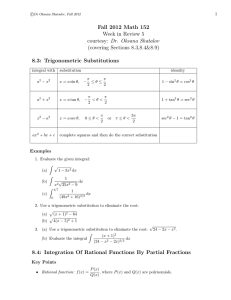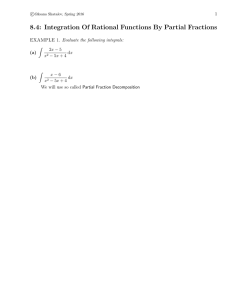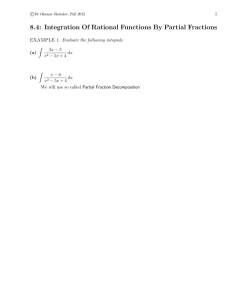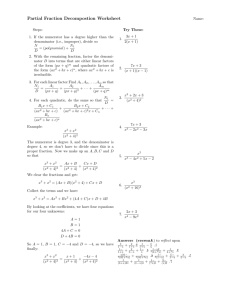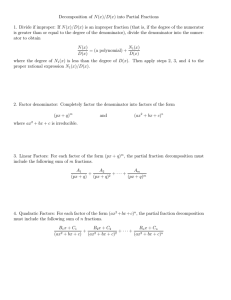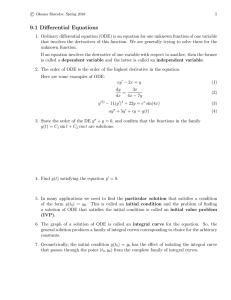Document 10581868
advertisement
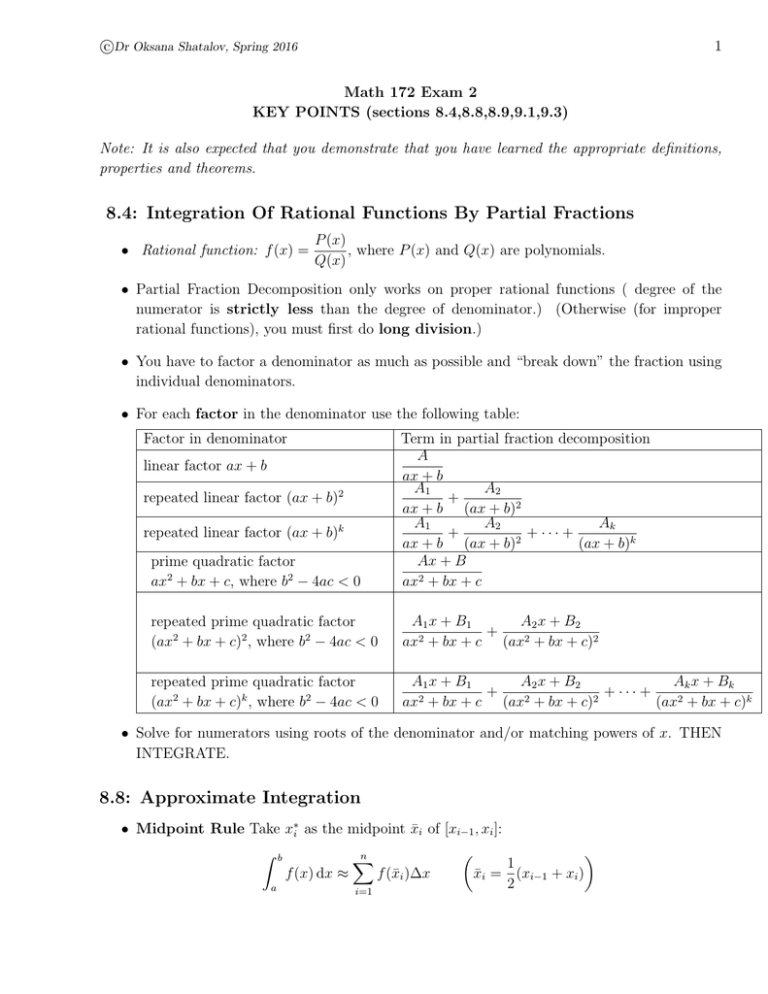
c Dr Oksana Shatalov, Spring 2016 1 Math 172 Exam 2 KEY POINTS (sections 8.4,8.8,8.9,9.1,9.3) Note: It is also expected that you demonstrate that you have learned the appropriate definitions, properties and theorems. 8.4: Integration Of Rational Functions By Partial Fractions • Rational function: f (x) = P (x) , where P (x) and Q(x) are polynomials. Q(x) • Partial Fraction Decomposition only works on proper rational functions ( degree of the numerator is strictly less than the degree of denominator.) (Otherwise (for improper rational functions), you must first do long division.) • You have to factor a denominator as much as possible and “break down” the fraction using individual denominators. • For each factor in the denominator use the following table: Factor in denominator prime quadratic factor ax2 + bx + c, where b2 − 4ac < 0 Term in partial fraction decomposition A ax + b A1 A2 + ax + b (ax + b)2 A2 Ak A1 + + ··· + 2 ax + b (ax + b) (ax + b)k Ax + B ax2 + bx + c repeated prime quadratic factor (ax2 + bx + c)2 , where b2 − 4ac < 0 A2 x + B2 A1 x + B1 + 2 ax + bx + c (ax2 + bx + c)2 repeated prime quadratic factor (ax2 + bx + c)k , where b2 − 4ac < 0 A1 x + B1 A2 x + B2 Ak x + Bk + + ··· + 2 2 2 ax + bx + c (ax + bx + c) (ax2 + bx + c)k linear factor ax + b repeated linear factor (ax + b)2 repeated linear factor (ax + b)k • Solve for numerators using roots of the denominator and/or matching powers of x. THEN INTEGRATE. 8.8: Approximate Integration • Midpoint Rule Take x∗i as the midpoint x̄i of [xi−1 , xi ]: Z b f (x) dx ≈ a n X i=1 f (x̄i )∆x 1 x̄i = (xi−1 + xi ) 2 c Dr Oksana Shatalov, Spring 2016 2 • Trapezoid Rule Z b f (x) dx ≈ a ∆x (f (x0 ) + 2f (x1 ) + . . . + 2f (xn−1 ) + f (xn )) , 2 where xi = a + i∆x. • Error Bound formulas: Suppose |f 00 (x)| ≤ K for a ≤ x ≤ b. If you are asked to find an up- per bound on the error, these formulas will be provided on the exam. Error Bound for Midpoint Rule: |EM | ≤ K(b−a)3 24n2 Error Bound for Trapezoid Rule: |ET | ≤ K(b−a)3 12n2 8.9: Improper Integrals • TYPE and Continuous Integrand: Z t Z ∞ I: Infinite Interval f (x) dx (likewise with −∞) f (x) dx = lim a t→∞ a • TYPE II: Discontinuous IntegrandZ and Finite Interval: Z b b f (x) dx = lim+ f (x) dx (likewise with b− ) f (x) is discontinuous at x = a: a Z • FACT: If a > 0 then a ∞ t→a t 1 dx is convergent as p > 1 and divergent as p ≤ 1. xp • Comparison Theorem: Let f (x) and g(x) be continuous and f (x) ≥ g(x) ≥ 0 for x ≥ a. Then Z ∞ Z ∞ – if f (x) dx is convergent then g(x) dx is convergent. a a Z ∞ Z ∞ (Note if f (x) dx is divergent, no conclusion can be drawn about g(x) dx.) a a Z ∞ Z ∞ – if g(x) dx is divergent then f (x) dx is divergent. a a Z ∞ Z ∞ (Note if g(x) dx is convergent, no conclusion can be drawn about f (x) dx.) a a 9.1: Differential Equations • Ordinary differential equation (ODE) is an equation for one unknown function of one variable that involves the derivatives of this function. We are generally trying to solve these for the unknown function. If an equation involves the derivative of one variable with respect to another, then the former is called a dependent variable and the latter is called an independent variable. • The order of ODE is the order of the highest derivative in the equation. c Dr Oksana Shatalov, Spring 2016 3 • Separable ODE is any ODE that is expressible in one of the following forms: y 0 = f (t)g(y), p(y) dy = q(t). dt • In many applications we need to find the particular solution that satisfies a condition of the form y(t0 ) = y0 . This is called an initial condition and the problem of finding a solution of ODE that satisfies the initial condition is called an initial value problem (IVP). • The graph of a solution of ODE is called an integral curve for the equation. • Brine Problems: Suppose a tank contains L Liters of salt water (could contain no salt at time t = 0). Now lets suppose a salt concentration I is going into the tank at a given rate R, the solution is continually stirred and it is exiting the tank at the same rate. Then if y = y(t) is the amount of salt in the tank at time t, then dy = I · R − Ly · R, and y(0) = dt amount of salt in the tank at time t = 0. Then solve for y. 9.3: Arc Length Z • Arc length of curve C: Z • Z β s ds = α Z • Z b ds = dx dt s 2 1+ a Z • Z ds = d s 1+ c ds + dy dx 2 dx dy 2 dy dt 2 dt when C is given by x = x(t), y = y(t), α ≤ t ≤ β; dx when C is given by y = y(x), a ≤ x ≤ b; dy when C is given by x = x(y), c ≤ y ≤ d.
